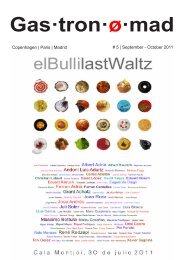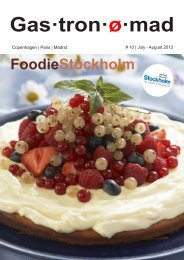Gastronomad #8 March - April 2012
Create successful ePaper yourself
Turn your PDF publications into a flip-book with our unique Google optimized e-Paper software.
BØN·APPETIT<br />
The knife that hits the market is a<br />
strange mixture of a chef’s knife<br />
(Gyuto) and a Nakiri knife. Its creators<br />
decided that this would be the<br />
ideal knife for a woman who had<br />
grown up with a Nakiri knife in that<br />
it is double-bevelled and curved<br />
but also pointed like a Western<br />
knife. It could thus be used effectively<br />
for meat as well as veggies.<br />
For fish, the Deba still reigned,<br />
even if they could buy fish already<br />
cut by the fishmonger.<br />
This new knife eventually settled<br />
down with two principal names:<br />
Santoku and Bunkabocho. “Santoku”<br />
does indeed refer to the<br />
three Buddhist virtues (of which<br />
there is more than one set), and<br />
seems to have been a marketing<br />
device proclaiming: “this knife is<br />
thrifty and Japanese as well as<br />
clever and Western!”<br />
Le couteau mis en vente est un<br />
mariage étrange d’un couteau de<br />
chef (gyuto) et d’un couteau nakiri.<br />
Ses créateurs pensaient que<br />
cette forme serait idéale pour une<br />
femme qui avait grandi avec un<br />
nakiri, tout en ajoutant un double<br />
biseau courbé et pointu comme<br />
dans les couteaux occidentaux. Il<br />
devait être efficace pour couper<br />
la viande ainsi que les légumes.<br />
Pour les poissons, le couteau deba<br />
régnait encore, même si souvent<br />
le poisson était acheté déjà coupé<br />
dans les poissonneries.<br />
Ce nouveau couteau portait deux<br />
noms principaux: Santoku et Bunkabocho.<br />
«Santoku» fait référence<br />
aux trois vertus bouddhistes, utilisées<br />
pour le marketing: «ce couteau<br />
est économique, japonais et<br />
aussi intelligent qu’un occidental !»<br />
El cuchillo que sale al mercado es<br />
una mezcla extraña de un cuchillo<br />
de chef (gyuto) y de un cuchillo<br />
nakiri. Sus creadores deciden<br />
que esta forma sería la ideal para<br />
una mujer que había crecido con<br />
un nakiri, añadiéndole un doble<br />
bisel curvo y afilado como en un<br />
cuchillo occidental. Debía ser eficaz<br />
para cortar la carne y las verduras.<br />
Para el pescado, el cuchillo<br />
tipo deba seguía prevaleciendo,<br />
aunque a menudo el pescado era<br />
comprado ya cortado en las pescaderías.<br />
Este nuevo cuchillo tenía dos<br />
nombres principales: Santoku y<br />
Bunkabocho. “Santoku” se refiere<br />
a las tres virtudes budistas que<br />
fueron utilizadas por el marketing:<br />
“¡este cuchillo es económico, japonés<br />
y tan inteligente como un<br />
occidental!”<br />
A taste of history | Le saveur de l´histoire | El sabor de la historia<br />
6 Gastronømad Gastronømad 7













